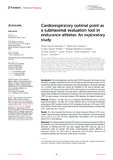Mostrar el registro sencillo del ítem
Cardiorespiratory optimal point as a submaximal evaluation tool in endurance athletes: an exploratory study
| dc.creator | Oyarzo-Aravena, Alexis | es_ES |
| dc.creator | Arce Álvarez, Alexis | es_ES |
| dc.creator | Salazar Ardiles, Camila | es_ES |
| dc.creator | Ramírez Campillo, Rodrigo | es_ES |
| dc.creator | Álvarez, Cristian | es_ES |
| dc.creator | Toledo, Camilo | es_ES |
| dc.creator | Izquierdo Redín, Mikel | es_ES |
| dc.creator | Andrade, David C. | es_ES |
| dc.date.accessioned | 2023-06-15T09:09:16Z | |
| dc.date.available | 2023-06-15T09:09:16Z | |
| dc.date.issued | 2023 | |
| dc.identifier.citation | Oyarzo-Aravena, A., Arce-Alvarez, A., Salazar-Ardiles, C., Ramirez-Campillo, R., Alvarez, C., Toledo, C., Izquierdo, M., & Andrade, D. C. (2023). Cardiorespiratory optimal point as a submaximal evaluation tool in endurance athletes: An exploratory study. Frontiers in Physiology, 14, 1087829. https://doi.org/10.3389/fphys.2023.1087829. | en |
| dc.identifier.issn | 1664-042X | |
| dc.identifier.uri | https://hdl.handle.net/2454/45487 | |
| dc.description.abstract | Introduction: The cardiorespiratory optimal point (COP) represents the lowest minute ventilation to oxygen consumption ratio (VE/VO2) and can be estimated during a CPET at submaximal intensity when an exercise test until volitional fatigue is not always advisable (i.e., a conflict zone where you cannot be confident of the security because nearcompetition, off-season, among other). COP’s physiological components have not been wholly described yet. Therefore, this study seeks to identify the determinants of COP in highly trained athletes and its influence on maximum and sub-maximum variables during CPET through principal c omponent analysis (PCA) (explains the dataset’s variance). Methods: Female (n = 9; age, 17.4 ± 3.1 y; maximal VO2 [VO2max]), 46.2 ± 5.9 mL/ kg/min) and male (n = 24; age, 19.7 ± 4.0 y; VO2max, 56.1 ± 7.6 mL/kg/min) athletes performed a CPET to determine the COP, ventilatory threshold 1 (VT1) and 2 (VT2), and VO2max. The PCA was used to determine the relationship between variables and COP, explaining their variance. Results: Our data revealed that females and males displayed different COP values. Indeed, males showed a significant diminished COP compared to the female group (22.6 ± 2.9 vs. 27.2 ±3.4 VE/VO2, respectively); nevertheless, COP was allocated before VT1 in both groups. Discussion: PC analysis revealed that the COP variance was mainly explained (75.6%) by PC1 (expired CO2 at VO2max) and PC2 (VE at VT2), possibly influencing cardiorespiratory efficiency at VO2max and VT2. Our data suggest that COP could be used as a submaximal index to monitor and assess cardiorespiratory system efficiency in endurance athletes. The COP could be particularly useful during the offseason and competitive periods and the return to the sports continuum. | en |
| dc.description.sponsorship | This study was supported by Minera Escondida Ltda. MEL2203; the “Agencia Nacional de Investigación y Desarrollo (ANID)”, through Fondecyt de Iniciación #11220870 and Anillo ACT210083. | en |
| dc.format.mimetype | application/pdf | en |
| dc.format.mimetype | application/vnd.ms-excel | en |
| dc.language.iso | eng | en |
| dc.relation.ispartof | Frontiers in Physiology 14:1087829 | en |
| dc.rights | © 2023 Oyarzo-Aravena, Arce-Alvarez, Salazar-Ardiles, Ramirez-Campillo, Alvarez, Toledo, Izquierdo and Andrade. This is an open-access article distributed under the terms of the Creative Commons Attribution License (CC BY). The use, distribution or reproduction in other forums is permitted, provided the original author(s) and the copyright owner(s) are credited and that the original publication in this journal is cited, in accordance with accepted academic practice. No use, distribution or reproduction is permitted which does not comply with these terms. | en |
| dc.rights.uri | http://creativecommons.org/licenses/by/4.0/ | |
| dc.subject | Musculoskeletal and neural physiological phenomena | en |
| dc.subject | Exercise test | en |
| dc.subject | Oxygen consumption | en |
| dc.subject | Anaerobic threshold | en |
| dc.subject | Athletic performance | en |
| dc.subject | Physical endurance | en |
| dc.title | Cardiorespiratory optimal point as a submaximal evaluation tool in endurance athletes: an exploratory study | en |
| dc.type | Artículo / Artikulua | es |
| dc.type | info:eu-repo/semantics/article | en |
| dc.date.updated | 2023-06-15T08:57:34Z | |
| dc.contributor.department | Ciencias de la Salud | es_ES |
| dc.contributor.department | Osasun Zientziak | eu |
| dc.rights.accessRights | Acceso abierto / Sarbide irekia | es |
| dc.rights.accessRights | info:eu-repo/semantics/openAccess | en |
| dc.identifier.doi | 10.3389/fphys.2023.1087829 | |
| dc.relation.publisherversion | https://doi.org/10.3389/fphys.2023.1087829 | |
| dc.type.version | Versión publicada / Argitaratu den bertsioa | es |
| dc.type.version | info:eu-repo/semantics/publishedVersion | en |
Ficheros en el ítem
Este ítem aparece en la(s) siguiente(s) colección(ones)
La licencia del ítem se describe como © 2023 Oyarzo-Aravena, Arce-Alvarez,
Salazar-Ardiles, Ramirez-Campillo,
Alvarez, Toledo, Izquierdo and Andrade.
This is an open-access article distributed
under the terms of the Creative Commons
Attribution License (CC BY). The use,
distribution or reproduction in other
forums is permitted, provided the original
author(s) and the copyright owner(s) are
credited and that the original publication in
this journal is cited, in accordance with
accepted academic practice. No use,
distribution or reproduction is permitted
which does not comply with these terms.



